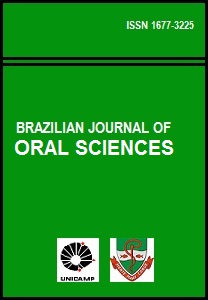Abstract
The aim of this study was to evaluate the effect of dentin blood contamination during different steps of the restorative procedure on resin cement shear bond strength to dentin. Crows of 120 bovine incisors were prepared to obtain flat superficial dentin surfaces. Dentin was etched with phosphoric acid and contaminated with fresh blood for 10 seconds, before or after adhesive system application. Different treatments were tested in contaminated dentin, resulting on eight groups (N=15). Composite resin restorations (TPH Spectrum, Dentsply) were adhesively fixed (Excite, Ivoclar-Vivadent) with resin cement (Variolink 2, Ivoclar-Vivadent) and shear bond strength test (0.5 mm/min) was performed. Morphologic observations were carried out with scanning electron microscopy (SEM). Data (MPa) were submitted to one-way ANOVA following Tukey’s test (p<0.05), showing that blood contamination during adhesive procedure negatively affects bond strength, and decontamination methods do not recover original bond strength. The negative effects of blood contamination on shear bond strength to dentin and resin cement were significant in all contaminated groups; none of the tested dentin treatment procedures resulted in higher bond strength irrespective of the moment on which blood contamination took place.References
Torii Y, Itou K, Nishitani Y, Ishikawa K, Suzuki K. Effect of phosphoric acid etching prior to self-etching primer application on adhesion of resin composite to enamel and dentin. Am J Dent. 2002; 15: 305-8.
Van Meerbeek B, De Munck J, Yoshida Y, Inoue S, Vargas M, Vijay P, et al. Buonocore memorial lecture. Adhesion to enamel and dentin: current status and future challenges. Oper Dent. 2003; 28: 215-35.
Eiriksson SO, Pereira PN, Swift EJ, Heymann HO, Sigurdsson A. Effects of blood contamination on resin-resin bond strength. Dent Mater. 2004; 20: 184-90.
Cacciafesta V, Sfondrini MF, Scribante A, De Angelis M, Klersy C. Effects of blood contamination on the shear bond strengths of conventional and hydrophilic primers. Am J Orthod Dentofacial Orthop. 2004; 126: 207-12.
Hobson RS, Ledvinka J, Meechan JG. The effect of moisture and blood contamination on bond strength of a new orthodontic bonding material. Am J Orthod Dentofacial Orthop. 2001; 120: 54-7.
Kaneshima T, Yatani H, Kasai T, Watanabe EK, Yamashita A.
The influence of blood contamination on bond strengths between dentin and an adhesive resin cement. Oper Dent. 2000; 25: 195-201.
Yoo HM, Pereira PN. Effect of blood contamination with 1- step self-etching adhesives on microtensile bond strength to dentin. Oper Dent. 2006; 31: 660-5.
Abdalla AI, Davidson CL. Bonding efficiency and interfacial morphology of one-bottle adhesives to contaminated dentin surfaces. Am J Dent. 1998; 11: 281-5.
Xie J, Powers JM, McGuckin RS. In vitro bond strength of two adhesives to enamel and dentin under normal and contaminated conditions. Dent Mater. 1993; 9: 295-9.
De Munck J, Van Landuyt K, Peumans M, Poitevin A, Lambrechts P, Braem M, et al. A critical review of the durability of adhesion to tooth tissue: methods and results. J Dent Res. 2005; 84: 118-32.
Baier RE, Shafrin EG, Zisman WA. Adhesion: mechanisms that assist or impede it. Science. 1968; 162: 1360-8.
Pashley DH, Carvalho RM. Dentine permeability and dentine adhesion. J Dent. 1997; 25: 355-72.
Wakabayashi Y, Kondou Y, Suzuki K, Yatani H, Yamashita A. Effect of dissolution of collagen on adhesion to dentin. Int J Prosthodont. 1994; 7: 302-6.
Prati C, Chersoni S, Pashley DH. Effect of removal of surface collagen fibrils on resin-dentin bonding. Dent Mater. 1999; 15: 323-31.
Wang Y, Spencer P. Hybridization efficiency of the adhesive/ dentin interface with wet bonding. J Dent Res. 2003; 82: 141-5.
Tay FR, Pashley DH, Yiu CK, Sanares AM, Wei SH. Factors contributing to the incompatibility between simplified-step adhesives and chemically-cured or dual-cured composites. Part I. Single-step self-etching adhesive. J Adhes Dent. 2003; 5: 27- 40.
Della Bona A, van Noort R. Shear vs. tensile bond strength of resin composite bonded to ceramic. J Dent Res. 1995; 74: 1591- 6.
Pashley DH, Sano H, Ciucchi B, Yoshiyama M, Carvalho RM. Adhesion testing of dentin bonding agents: a review. Dent Mater. 1995; 11: 117-25.
Dietrich T, Kraemer ML, Roulet JF. Blood contamination and dentin bonding—effect of anticoagulant in laboratory studies. Dent Mater. 2002; 18: 159-62.
GaRey DJ, Tjan AH, James RA, Caputo AA. Effects of thermocycling, load-cycling, and blood contamination on cemented implant abutments. J Prosthet Dent. 1994; 71: 124- 32.
Cacciafesta V, Sfondrini MF, De Angelis M, Scribante A, Klersy C. Effect of water and saliva contamination on shear bond strength of brackets bonded with conventional, hydrophilic, and self-etching primers. Am J Orthod Dentofacial Orthop. 2003; 123: 633-40.
Park JW, Lee KC. The influence of salivary contamination on shear bond strength of dentin adhesive systems. Oper Dent. 2004; 29: 437-42.
Anusavice KJ. Phillips’ Science of Dental Materials. 11th ed. St. Louis: WB Saunders; 2003.
The Brazilian Journal of Oral Sciences uses the Creative Commons license (CC), thus preserving the integrity of the articles in an open access environment.


